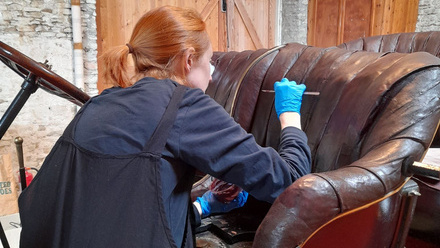10,000 miles from Icon: Accreditation in the age of Zoom
For every cloud there is a silver lining
When COVID-19 really began to impact the global community in March 2020, the outlook was dismal. I had just submitted my Icon Accreditation Stage Two application and was doing my best to come up with a solution for a potential problem; if my Stage 2 application was successful, how was I to get two assessors from the UK to conduct my assessment in Australia? At the time, online assessments were out of the question to ensure equality for all accreditation applicants. With the onset of COVID-19 travel restrictions, my hopes of piggy-backing my assessment off an Australian conference or courier trip were dashed. However, as the global situation developed, public meetings domestically and globally ceased. The online meeting soon became (and still remains) the new norm. In December I received the good news my Stage Two application was successful. Now it was time to prepare for the assessment. What had seemed like an impossible or extremely expensive problem now became attainable. The new challenge then became, how do I accomplish this?
Preparation
My application from beginning to end straddled the period before and after the introduction of the new revised Pathway membership introduced in 2019. During my Stage Two application, I utilised the mentorship resource offered as part of Pathway membership. Working with a mentor was a valuable and insightful experience. In preparation for my assessment I made use of the experience and knowledge of my peers through the informal avenue of social media communications apps. My conservation colleagues and friends are scattered worldwide, so social media as a form of communication during COVID-19 provided quick informal responses, knowledge sharing and sharing of images and resources, helping me prepare mentally and practically for my assessment.
Leading up to assessment, the resources and literature available on the Icon website were invaluable. I relied heavily on the Icon Accreditation Candidate and Volunteer Handbook and Icon Accreditation Guide for assessment preparation. These documents, along with the Icon website, provided me with a wealth of information to prepare for assessment. Guidance is given from technological advice for an online assessment, through to suggested format and essential requirements. These resources, coupled with my Stage Two application and Accreditation Committee feedback, ensured good familiarity with the Professional Standards and Judgement and Ethics criteria, and identified gaps highlighted in my feedback.
Logistics
A major consideration for my assessment was the time difference between the UK and Australia. I was able to negotiate with my assessors two dates that best met all our availabilities, and were within reasonable boundaries of work hours. The assessment was scheduled to be conducted over two consecutive evenings in Australia, and therefore two mornings for my assessors in the UK.
Once the dates were confirmed, setting up the assessment became a logistical and technological challenge. Icon has a Zoom account which can be made available to assessment participants, however security restrictions at my workplace prevented the use of Zoom as a platform. COVID-19 social distancing restrictions meant face-to-face training at my workplace were moved online, and the platform of choice was Adobe Connect. I therefore had an account available to me provided by my employer. My assessors were not familiar with the platform, but I was able to provide them with links to online YouTube tutorials on the use of Adobe Connect prior to the assessment. This meant that my assessors were able to familiarise themselves with the software before getting started.
Assessment Day
The Icon Accreditation Portfolio Coversheet helped me manage and visualise all the material I needed to prepare and provide for assessment. To supply my assessors with as much information as possible, I sent all of my documents to them beforehand using a shared Google Drive folder. This way, my assessors could have access to the supporting documentation whenever they required it. It was vital for me to be well prepared and ensure everything was presented to my assessors in a timely manner. This wasn’t always the case (with some last minute inclusions), however, my assessors were very understanding and accommodating, and were able to make allowances to ensure I was able to do my best for the assessment.
For the assessment agenda, I referred to the resources provided in the Icon Accreditation Guide for assessment preparation. From this, I formed the schedule for the assessment as below:
Day 1
- Introduction to myself and my career to date
- Project A, demonstrating Standard 4
- Project B, demonstrating Standard 1
- Project C, demonstrating Standard 2
Day 2
- Project D, demonstrating Standard 3
- Project E, demonstrating Standard 5
- Project F, demonstrating Judgement & Ethics
- Questions and wrapping up
For the presentations I broke down each project into the individual standard criteria. Each slide was titled with the corresponding criteria title and reference number. This helped the assessors relate the slides to the respective criteria. This also kept me on topic, and provided cue words and phrases to keep me on track and focus my discourse. My slides were predominantly images with very little text. This meant my assessors could concentrate on what I was saying, rather than having to read slides. After each presentation we took a short break to refresh for the next presentation. This process worked well for an online assessment, and meant the assessment was divided into more manageable segments.
In Summary
Online assessment has its pros and cons. The ability to conduct the assessment from the comfort of their own home or office was convenient for the assessors. The presentation method provided a more structured approach for me, alleviating the nerves associated with ad lib discussion. Making the supporting documentation available to my assessors prior to the assessment saved time, and ensured flow during presentations and discussion. In contrast to these advantages, engaging with people online is difficult, and I was concerned by the volume of PowerPoint presentations. We were very lucky that technical difficulties were minimal and minor during my assessment, but this creates an added level of anxiety to any assessment process. The time difference between the UK and Australia meant scheduling a suitable date and time for all parties was problematic, but not impossible. Although, it did mean I had two very long and exhausting days in a row!
Advice for Online Assessment
- Utilise a mentor through Pathway membership
- Discuss your assessment with your peers for further guidance and ideas
- Make use of all the available Icon literature and resources
- Scrutinise your Stage Two application and Accreditation Committee feedback to identify gaps
- Compile and provide your documentation evidence well in advance
- Plan and prepare your method of presentation
- Utilise the Icon Training and Development team – they were always very willing and able to assist
Above all, enjoy the process and have confidence in your professional ability as an experienced conservator reaching this career milestone!






